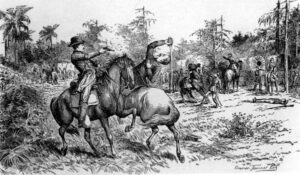
from Dickison and His Men
Reminiscences of the War in Florida
In February 1865 the 17th Connecticut was ordered to Florida following the Union defeat at the Battle of Olustee. Upon their arrival in Jacksonville, Col Noble assumed command of the 2nd Brigade. After about a month without incident, the Union force at Jacksonville was broken up and while most of the regiments returned north, the 17th Connecticut was sent to St. Augustine to relieve the 10th Connecticut while the Ohio regiments remained at Jacksonville. The 17th remained headquartered at St. Augustine until the war’s end; one company stationed at Fort Marion, while the rest were raiding or scattered at outposts.
Their service in seemingly quiet northeastern Florida was anything but quiet for the regiment. On April 25, 1864, Col. Noble started on a foraging raid with a large part of his brigade, including the 17th to Volusia, 75 miles up the St. John’s River. On April 28 they captured large amounts of cotton and 1,000 head of cattle. They returned to St. Augustine three days later but left troops to hold posts at Welaka and Saunders. On May 19, Company B was captured at Welaka. The force of 40 men and two officers were taken to Andersonville prison. Many soldiers of Company B died or suffered life-long debilitation from the effects of their captivity. Two other companies posted at Volusia held out until relieved. The regiment participated in various raids throughout this time. Colonel Noble was captured himself on December 24, 1864, and spent the rest of the war at Andersonville Prison.
On February 4, 1865, Lt. Col. Albert Wilcoxson, then in command of the 17th, was mortally wounded and his adjutant killed at Dunn’s Lake, FL while on an expedition to Braddock’ s Farm some 50 miles from St. Augustine. Thirty men were also captured and taken to Andersonville. Lt. Colonel Wilcoxson was the 3rd lieutenant colonel killed in action with the regiment. The 17th served without incident for the remainder of the winter and spring of 184 and 1865.
Links to 17th Connecticut in Florida Pages
- Brothers of the Mystic Tie – the Story of Lt. Colonel Albert Wilcoxson (by Matthew M. Morris
